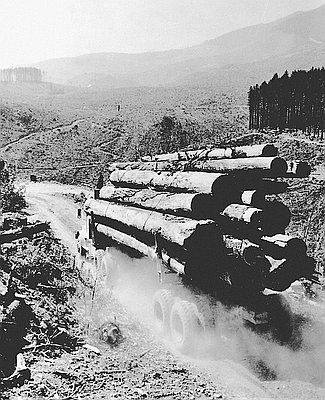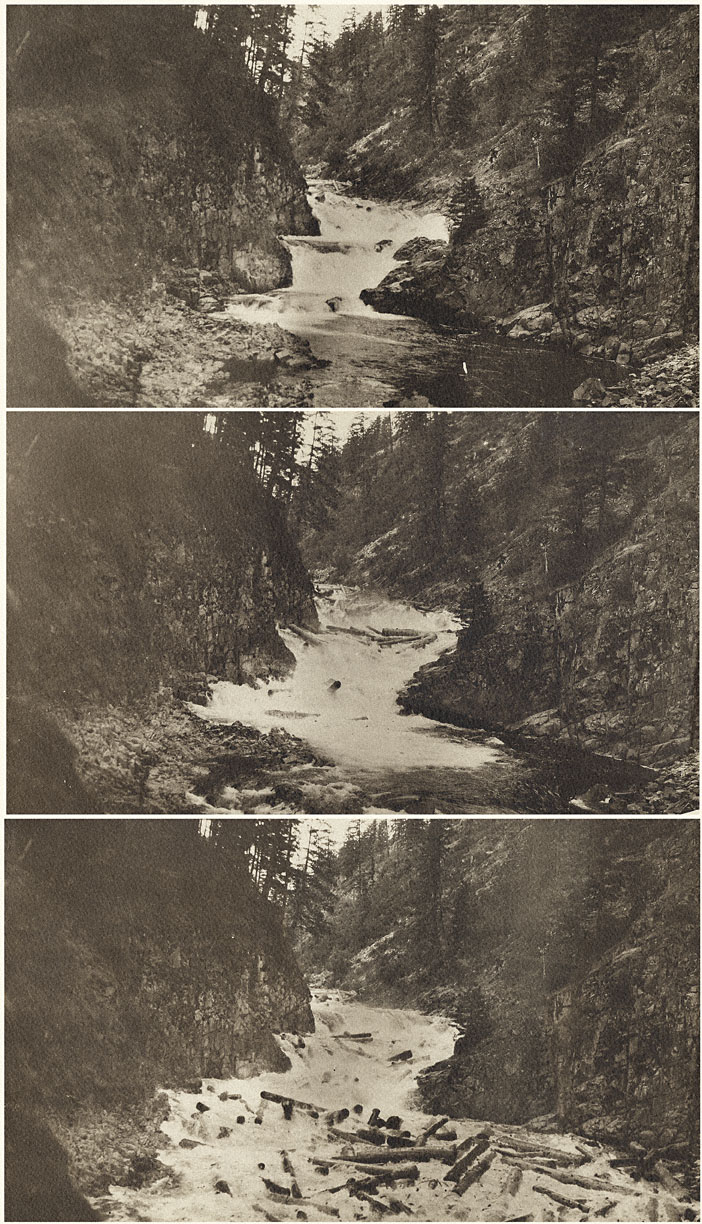- Catalog No. —
- OrHi 86531, OrHi 105148, OrHi 86528
- Date —
- c. 1910s
- Era —
- 1881-1920 (Industrialization and Progressive Reform)
- Themes —
- Environment and Natural Resources, Trade, Business, Industry, and the Economy, Transportation and Communication
- Credits —
- Oregon Historical Society
- Regions —
- Columbia River
- Author —
- Unknown
Wind River Log Drive
This sequence of photographs shows logs released from behind a splash dam moving through southern Washington’s Wind River. The photographs were most likely taken sometime between the early 1900s and the mid-1920s.
Today most logs are moved out of the woods on trucks, but in the nineteenth and early twentieth centuries, waterways were a major means of transporting logs from the forest to the mill. Since streamflow was insufficient in many streams to float logs, timber companies built splash dams, which created artificial ponds into which logs were dumped. The dams were then opened periodically, releasing a flood of water and logs downstream. Obstructions were often blasted out of streams to further improve the flow of logs.
The photo sequence reproduced above shows a flood of water and logs going through the confined channel of the Wind River. The Storey-Keeler Lumber Company built the splash dam on the Wind River in 1902, the same year the company was bought out by the Wind River Lumber Company. The logs shown here were on their way to the mouth of the Wind River, where they were tied together and floated down the Columbia to the Wind River Lumber Company’s mill at Cascade Locks.
The Wind River Lumber Company operated the Wind River splash dam and other splash dams in the Wind River Basin until 1925, when the company went bankrupt after a large fire destroyed much of their equipment and four and half million board feet of felled timber.
While useful to industry, splash dams were destructive of fish life, particularly salmon and other migratory fish. These dams were rarely built with fish ladders, and the flood of water and logs killed fish outright, scoured their spawning beds, and eroded streambanks. The logging of riparian forests and the dynamiting of log jams and river obstructions resulted in additional impacts to fish populations.
Further Reading:
Sinclair, Donna. “Contested Visions of Place: People, Power, and Perception on the Columbia’s North Shore, 1805-1913.” Master’s thesis, Portland State University, 2004.
Tolfree, Jamie. “History of the Wind River Lumber Company in the Upper Wind River Valley.” Skamania County Heritage 13, 1984: 3-7, 3-11.
Written by Joshua Binus, © Oregon Historical Society, 2004.
Related Historical Records
-
Log Truck Stirs Dust through Clearcut
This undated photograph from the Timberman is identified as being from the Pacific Northwest. Although the title accompanying the photograph in the collection identifies the surrounding logging operation as …

-
Lumber Mills and Irrigation Dams
Due to severe overstocking of the range during World War I—brought on by federal policies and soaring prices for meat, leather, and tallow and followed by a sudden …
